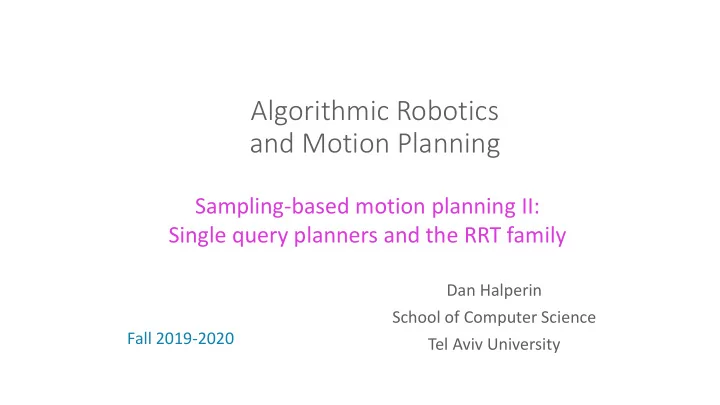

Algorithmic Robotics and Motion Planning Sampling-based motion planning II: Single query planners and the RRT family Dan Halperin School of Computer Science Fall 2019-2020 Tel Aviv University
Overview • RRT • bi-RRT • Poor quality solution paths • RRT* • Variants • References
Two landmark papers
The pseudocode (and more) in the following slides is from *
RRT – Rapidly-exploring Random Tree
Voronoi bias • Reducing the dispersion = reducing the radius of the largest empty ball [LaValle ’ s book]
Voronoi bias, cont ’ d • The exploration strategy of RRT has the Voronoi bias property: The probability of a node in the tree to be expanded is proportional to the volume of its Voronoi cell in the Voronoi diagram of the existing nodes • The strategy can be viewed (roughly) as aiming to reduce the dispersion • To exactly reduce the dispersion we should grow the tree toward the Voronoi vertex most distant from the tree nodes, from one of its nearest neighbors animation
BiRRT – Bidirectional RRT • One can grow two trees T s , T t from start and target • In every iteration select one of the trees for expansion • Force the trees to meet: • Every once in a while attempt to extend both trees toward the same sample • Approach is helpful when one of the sides is harder than the other
RRT, path quality • RRT is probabilistically complete • But can produce arbitrarily bad paths
Experiments (I) • 49.4% of paths are over three times worse than optimal (even after smoothing) • much larger than the theoretical bound
Experiments (II) – Close-By Start and Goal Configurations • 5.9% of paths are over 140 times worse than optimal (even after smoothing) • Conclusion: visibility blocking may be as important as narrow passages
Experiments with 3D Cube-Within-Cube • 97.3% (!) of paths are over 1.2 times worse than optimal after smoothing • Typically much more
RRT* Enter Karaman and Frazzoli, 2011
Asymptotic optimality • A motion planner is asymptotically optimal if the solution returned by it converges to the optimal solution, as the number of samples tends to infinity
Robustly feasible motion-planning problem [Solovey et al, 2019]
Asymptotic optimality of RRT* [Solovey et al, 2019]
Variants
Speedup: Informed RRT* [Gammell et al., 2014] • Denote by c best the length of the shortest path found so far • Based on this knowledge, how can we speedup the convergence of the following iterations?
Speedup: Informed RRT* • Denote by c best the length of the shortest path found so far • Based on this knowledge, how can we speedup the convergence of the following iterations? • Observation: any point on a path shorter than c best must lie in a hyperellipsoid:
Speedup: Informed RRT* • Improvement: • Maintain an ellipsoid E; initially, it covers the whole space • Every time an improving solution is found update E • Generate new samples only from E • Optional: prune vertices that no longer lie in E
Remark: RRG [Karaman-Frazzoli, 2011] • Like the RRT* algorithm, but we simply make all the valid (collision free) connections between x new and the nodes in X near , with two edges in opposite direction for each node in X near • The RRT* tree is a subgraph of RRG • RRG requires more storage space and is practically more time consuming than RRT*
Tradeoff (speed vs. quality): LBT-RRT [Salzman-Halperin, 2014] • Lower-bound RRT: • Guarantees convergence to (1 + ε)OPT • When ε= 0 behaves like RRG • When ε=∞ behaves like RRT • An edge (v,v ’ ) is collision checked only if it can potentially improve the cost of any vertex on the shortest-path tree rooted in v ’ by at least 1 + ε
Further variants • RRT# • FMT* • SST • many more: see the surveys
References
Papers
Good starting point Sampling-based algorithms Chapter 7 of the book Principles of robot motion: theory, algorithms, and implementation by Choset et al The MIT Press 2005 comprehensive survey with many references
the book Planning Algorithms By Steven LaValle Camrdige University Press, 2006 in-depth coverage of motion planning available online for free! http://planning.cs.uiuc.edu/ online bibliography
More recent surveys • Sampling-Based Robot Motion Planning, Oren Salzman, Communications of the ACM, October 2019 • Robotics, Halperin, Kavraki, Solovey, in Handbook of Computational Geometry, 3rd Edition, 2018 • Sampling-Based Robot Motion Planning: A Review, Elbanhawi and Simic, IEEE Access, 2014 (free online)
THE END
Recommend
More recommend